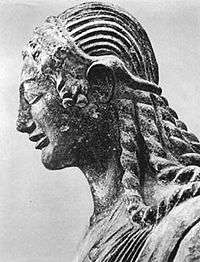List of Etruscan names for Greek heroes
This is a list of Etruscan names for Greek heroes. It is a partial list of the names in the list of Etruscan mythological figures.
- Achilles
- Achle, Achile. Legendary hero of the Trojan War.[1]
- Agamemnon
- Achmemrun. Legendary king of Mycenaean Greece.[1]
- Ajax, son of Telamon and Ajax, son of Oileus
- Aivas Tlamunus, Aivas Vilates; also Eivas or Evas.[2]
- Kallinikos
- Calanice. Greek name of Hercle.[4]
- Jason
- Easun, Heasun, Heiasun.
- Aitolos
- Etule. Confused with his brother, Epeios, who built the Trojan horse.[5]
- Amphiaraus
- Hamphiare, Amphare. Legendary seer.[6]
- Menelaus
- Menle. The hero of Trojan War fame.[8]
- Prometheus
- Prumathe.[11]
- Teucer
- Techrs. The Trojan War hero.[13]
- Theseus
- These.
- Odysseus
- Uthste
See also
Notes
- 1 2 3 4 The Bonfantes (2002), page 192.
- ↑ The Bonfantes (2002), page 193.
- 1 2 3 The Bonfantes (2002), page 194.
- 1 2 3 4 5 The Bonfantes (2002), page 195.
- 1 2 3 The Bonfantes (2002), page 198.
- 1 2 The Bonfantes (2002) page 199.
- ↑ The Bonfantes (2002), page 200.
- 1 2 The Bonfantes (2002), page 201.
- 1 2 3 4 The Bonfantes (2002), page 202.
- 1 2 3 The Bonfantes (2002), page 203.
- 1 2 The Bonfantes (2002) page 204.
- ↑ The Bonfantes (2002), page 205.
- 1 2 3 4 The Bonfantes (2002), page 206.
- ↑ Swaddling and Bonafante (2006) page 78.
- 1 2 The Bonfantes (2002), page 208.
- 1 2 The Bonfantes (2002), page 210.
- ↑ Swaddling & Bonfante page 42.
References
- Bonfante, Giuliano; Bonfante, Larissa (2002). The Etruscan Language: an Introduction. Manchester: University of Manchester Press. ISBN 0-7190-5540-7. Preview available on Google Books.
- De Grummond; Nancy Thomson (2006). Etruscan Mythology, Sacred History and Legend: An Introduction. University of Pennsylvania Museum of Archaeology. ISBN 1-931707-86-3. Preview available on Google Books.
- Dennis, George (1848). The Cities and Cemeteries of Etruria. London: John Murray. Available in the Gazetteer of Bill Thayer's Website at
- Leland, Charles Godfrey (1892). Etruscan Roman Remains in Popular Tradition. London: T. Fisher Unwin. Downloadable Google Books, online at .
- Pallottino, M. (1975). The Etruscans. London: Penguin Books.
- Richardson, Emeline Hill (1976) [1964]. The Etruscans: Their Art and Civilization. Chicago: University of Chicago Press. ISBN 0-226-71234-6.
- Swaddling, Judith & Bonfante, Larissa (2006). Etruscan Myths. University of Texas Press. ISBN 0-292-70606-5. Preview Google Books.
- Thulin, Carl (1906). Die Götter des Martianus Capella und der Bronzeleber von Piacenza. Alfred Töpelmann. A German-language book, downloadable from Google Books.
This article is issued from
Wikipedia.
The text is licensed under Creative Commons - Attribution - Sharealike.
Additional terms may apply for the media files.
